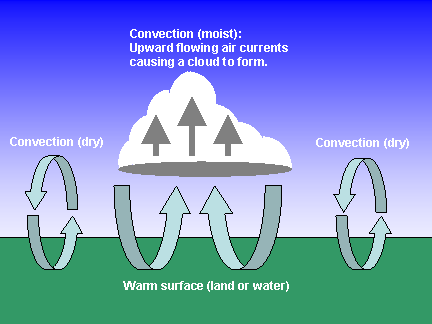
|
What is convection?
|
"Convection" has several, related meanings in weather....but it always involves rising
air. It usually refers to "moist convection", where the excess water vapor in rising air
parcels condenses to form a cloud.
The heat released
through this condensation can help to sustain the convection by warming the air further and making it
rise still higher, which causes more water vapor to condense, so the process feeds on itself.
But convection can also be dry, as occurs on a sunny day over the desert, or in more humid regions
early in the day before the convection has become strong enough to form clouds. The sun warms the ground, and
convective air currents help to remove the excess heat from the surface. Dry convection also occurs
during the day even when clouds are not forming...you just can't see it.
|
| Interesting facts:
|
| MAKING THE EARTH LIVEABLE: Convection (both dry and moist)
help to make the Earth liveable by removing excess heat from the surface, which is where most of the solar
energy is abrobed by the Earth, and transporting it
high into the atmosphere. It has been calculated that, without convection, the average surface air temperature
on the earth would be about 125 deg. F, rather than the current 59 deg. F.
|
| WHAT GOES UP, MUST COME DOWN: All of the air rising through
convection must be balanced by an equal amount of sinking air elsewhere. This, clouds represent
vertical circulation systems, involving rising air where the visible cloud forms, and sinking air around the cloud.
|
|
(page last updated 12/13/2019)
|



